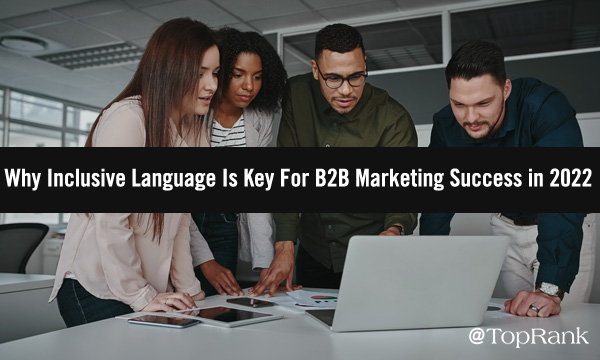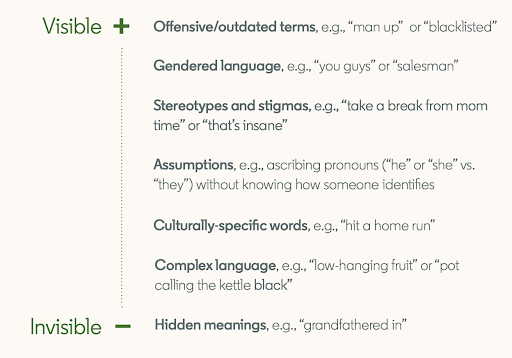
If you’re in the business of marketing, I don’t need to tell you that words have power.
They have the power to influence. The power to endear. The power to alienate.
If you’re in the business of marketing, I don’t need to tell you how undesirable that last effect is.
It’s the risk today’s brands are running if they fail to make inclusive language a priority. The words used in content and communications speak volumes about a company’s values.
Following a few simple guiding principles can make a big difference in projecting a brand culture and community that are welcoming to all, both externally and internally.
Defining “Inclusive Language” in Marketing
Inclusive language, as defined by our friends and clients at LinkedIn, is language that “does not exclude or stereotype people based on race, sexual orientation, age, gender identity, ability, socioeconomic status, or any other characteristic.”
Examples of inclusive language cover a wide range of visible and invisible forms. There’s no set playbook to follow, because the recommended guidelines and best practices are fluid, just as language is.

(Source: LinkedIn’s guide to Inclusive Language for Marketers)
Inclusive culture is a journey, not a destination. But it’s an extremely important one for B2B organizations to undertake. Emerging generations are more diverse than any before, and the modern world is more globally interconnected. Your future customers and employees want to see themselves reflected in your brand’s marketing. The stakes are high.
“The ability to communicate with all audiences is a sign of respect and demonstrates to prospective connections what to expect from your company,” says Rachel Douglas, Influencer Marketer. “Inclusive language can deepen relationships and leading brands understand the need to have an authentic, inclusive voice as part of their core identity.”
Why There’s “So Much Work to Be Done”
Last year, the AI-powered software company Creative X conducted an analysis of more than 3,500 image and video ads in the U.S. across popular CPG, beauty and alcohol brands, assessing representations of age, gender, skin tone and setting.
The study produced some stark findings:
- Although more than half (55%) of ads feature female characters, male characters were 1.5x more likely to be shown in professional settings.
- Characters with light to medium skin tones were shown twice as often in professional environments. Characters with darker skin tones were featured roughly half as frequently as their lighter-skinned counterparts — 18% compared to 8%.
- Only 1% of ads included people over 60, and of those, less than 2% were featured in physical settings (i.e. offices).
“Female characters are historically four to six times more sexualized and less depicted as leaders,” according to Madeline Di Nonno, president and CEO of the Geena Davis Institute on Gender in Media, in the aforementioned article. “And marginalized communities, LGBTQIA+, people with disabilities, they’re not even anywhere near the baseline population. There has been progress, but there’s so much work to be done.”
B2B brands and marketers have a key role to play in this work.
Taking the Journey Toward an Inclusive Culture
The single most important step marketing leaders can take today is to openly make inclusive language a priority.
Talk about it frequently in team meetings. Build it into your creative process. Seek different viewpoints on how a message or piece of content will be received by different audiences.
Moreover, here are some specific actions that will help embed inclusive language into your B2B marketing strategy:
- Create an inclusive language style guide, highlighting words and phrases to avoid as well as recommended alternatives. To get you started, the American Psychological Association has a lengthy list of guidelines. Ideally, your guide should be tailored to your company and its specific values; it should also be a living, breathing document that evolves continuously over time.
- Make diversity a focal point in hiring, across a variety of identity traits. Authentically infusing different worldviews and experiences into the creation of your marketing is the best way to make it resonate with diverse audiences.
- Set the standard from up top. When executives and leaders make a point of using inclusive language and calling out opportunities to do so, it sets an example for others to follow. Consider providing managers with free trainings on inclusive language and its principles.
- Review and evaluate past copy and content. Find instances of non-inclusive language from past content or ads (from your brand or others) and, as a team, identify better alternatives that could have been used. It’s helpful to see concrete, real-life examples to demonstrate more inclusive thinking.
- Maintain open and honest communication. As we said earlier, inclusive language is fluid and ever-changing. That’s why it should never be a set-and-forget initiative. Encourage team members to speak up and share ideas about how your guidelines can and should change over time.
What Message Are You Sending?
Seemingly small word choices and linguistic decisions can have a dramatic impact on how their source is perceived by readers or listeners. Keep in mind that nobody is expected to be perfect, and your audience will likely be forgiving of missteps if the intentions are clear and genuine.
The journey is well worth taking. As Maysa Akbar, Chief Diversity Officer for the APA, explains: “By embracing inclusive language and encouraging others to do the same, we firmly believe that we will not only communicate effectively with more people, but also better adapt to a diversifying society and globe.”
There’s work to be done, but B2B marketers are uniquely equipped to help their companies accomplish it. If you’re ready to make inclusive language a priority in your strategy, but unsure where to start, here are some valuable resources:
- Last year, LinkedIn not only created a pocket guide, but also a full learning course covering key marketing-focused elements like making a business case for inclusive language.
- This inclusive marketing resources roundup from Search Engine Land includes links to a bevy of useful materials, such as Harvard’s Implicit Association Test to evaluate your own biases, and guidance around website accessibility.
TopRank Marketing CEO Lee Odden wrote on our blog about how marketers can become more inclusive with content and influencers.
Source link



